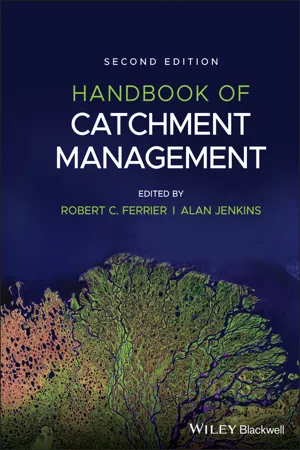
Handbook of Catchment Management
- English
- ePUB (mobile friendly)
- Available on iOS & Android
Handbook of Catchment Management
About this book
HANDBOOK OF CATCHMENT MANAGEMENT
In 2010, the first edition of the Handbook of Catchment Management provided a benchmark on how our understanding and actions in water management within a catchment context had evolved in recent decades. Over ten years on, the catchment management concept isentering a new phase of development aligned to contemporary and future challenges. These include climate change uncertainty, further understanding in ecological functioning under change, the drive for a low-carbon, energy efficient and circular society, multiple uses of water, the emergence of new pollutants of concern, new approaches to valuation, finance and pricing mechanisms, stewardship and community engagement, the integration of water across the Sustainable Development Goals (SDG) and the link between water, energy and food. These developments are framed within an increasingly data rich world where new analytics, sensor technology and processing power are informing increasingly real-time decision making. The challenge is also to increase cross-compliance and policy integration to meet multiple stakeholder objectives, and to link actions to achieve cost-effective outcomes. In addition, there are a number of new and exciting city, region and basin-scale real-world examples of contemporary and new catchment thinking; integrating science, technology, knowledge and governance to address multiple drivers and complex problems from across the globe. The time is now right, to capture the new challenges facing catchment management and water resources management globally.
This revised and updated edition of the Handbook of Catchment Management features:
- Thoroughly rewritten chapters which provide an up-to-date view of catchment management issues and contexts
- New case study material highlighting multi-sectoral management in different globally significant basins and different geographical locations
- Up-to-date topics selected for their resonance not only in natural sciences and engineering, but also in other fields, such as socio-economics, law and policy
The Handbook is designed for a broad audience, but will be particularly useful for advanced students, researchers, academics and water sector professionals such as planners, consultants and regulators.
Frequently asked questions
- Essential is ideal for learners and professionals who enjoy exploring a wide range of subjects. Access the Essential Library with 800,000+ trusted titles and best-sellers across business, personal growth, and the humanities. Includes unlimited reading time and Standard Read Aloud voice.
- Complete: Perfect for advanced learners and researchers needing full, unrestricted access. Unlock 1.4M+ books across hundreds of subjects, including academic and specialized titles. The Complete Plan also includes advanced features like Premium Read Aloud and Research Assistant.
Please note we cannot support devices running on iOS 13 and Android 7 or earlier. Learn more about using the app.
Information
1
Introduction to Catchment Management in 2020

1.1 Introduction
1.2 Historical Synopsis
Box 1.1 Global Cities Under Threat of Water Security
- São Paulo, Brazil
- Cape Town, South Africa
- Bangalore, India
- Beijing, China
- Cairo, Egypt
- Jakarta, Indonesia
- Moscow, Russia
- Istanbul, Turkey
- Mexico City, Mexico
- London, United Kingdom
- Tokyo, Japan
- Miami, United States of America
- Chennai, India
- Lima, Peru
Table of contents
- Cover
- Table of Contents
- Title Page
- Copyright
- List of Contributors
- Preface
- Acknowledgements
- 1 Introduction to Catchment Management in 2020
- 2 Water Diplomacy
- 3 Water Financing and Pricing Mechanisms
- 4 Defining ‘Smart Water’
- 5 Water, Food, and Energy Nexus
- 6 Groundwater Management
- 7 Diffuse Pollution Management
- 8 Emerging Contaminants and Pollutants of Concern
- 9 Flood Management
- 10 Ecological Restoration
- 11 Water, Sanitation, and Health: Progress and Obstacles to Achieving the SDGs
- 12 The Legal and Institutional Framework for Basin Management Across Governance Levels
- 13 Scotland the ‘Hydro Nation’: Linking Policy, Science, Industry, Regulation in Scotland and Internationally
- 14 Yorkshire Integrated Catchment Solutions Programme (iCASP): A New Model for Research‐Based Catchment Management
- 15 Integrated Management in Singapore
- 16 Flood and Drought Emergency Management
- 17 The River Chief System in China
- 18 Water Resources Management in the Colorado River Basin
- 19 Development in the Northern Rivers of Australia
- 20 Catchment Management of Lake Simcoe, Canada
- 21 Management of Water Resources on the Han River, Korea
- 22 Dispute Resolution in the Cauvery Basin, India
- 23 The Future for Catchment Management
- Index
- End User License Agreement